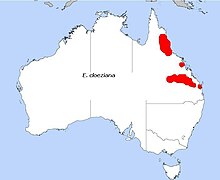Eucalyptus cloeziana
| Eucalyptus cloeziana | ||||||||||||
|---|---|---|---|---|---|---|---|---|---|---|---|---|

Eucalyptus cloeziana |
||||||||||||
| Systematics | ||||||||||||
|
||||||||||||
| Scientific name | ||||||||||||
| Eucalyptus cloeziana | ||||||||||||
| F. Garbage. |
Eucalyptus cloeziana is a species ofthe myrtle family (Myrtaceae). It occurs on the east coast of Queensland and in the adjacent Great Dividing Range and is called "Messmate", "Queensland Messmate", "Gympie Messmate", "Yellow Messmate" or "Dead Finish" there.
description
Appearance and leaf
Eucalyptus cloeziana grows as a tree that reaches heights of 10 to 35 meters, in the Gympie region up to 55 meters. The bark remains on the entire trunk or on the smaller branches, is pale brown, yellow-brown, gray-brown or brown and is parqueted. There are oil glands both in the pith of the young twigs and in the bark.
In eucalyptus cloeziana is Heterophyllie ago. The leaves are almost always divided into a petiole and a leaf blade. Only on seedlings are the first five to nine pairs of leaves opposite and sitting or only with short stalk. The green-gray leaf blades on seedlings are differently colored on the top and bottom and are elliptical to ovate, 6 to 10 centimeters long and 2 to 5 centimeters wide. On young specimens, the green leaf blade is differently colored on the underside and upper side, with a length of 9 to 15 cm and a width of 2.5 to 7 centimeters ovate to broadly lanceolate. On medium-old specimens, the dull gray-green leaf blade is 10 to 15 centimeters long and 3 to 4 centimeters wide, lanceolate to lanceolate, curved sickle-shaped and with entire margins. Sometimes the leaves on middle-aged specimens can also be sessile. The leaf blades on adult specimens are dull green in different colors on the upper and lower sides, are 8 to 13 centimeters long and 1 to 3 centimeters wide, relatively thin to narrow-lanceolate, curved sickle-shaped, tapers towards the base of the blades and have a pointed upper end. The side nerves, which are barely visible, extend from the median nerve at an obtuse or acute angle.
Inflorescence and flower
Employed side stalk round at a at a length of 5 to 10 millimeters and a diameter of up to 3 millimeters in cross-section, narrow-edged flattened or inflorescence stem are in composite total inflorescences about siebenblütige part inflorescences. The flower stalks are 1 to 4 millimeters long. The not blue-green floured or frosted flower buds are ovoid or club-shaped with a length of 4 to 7 millimeters and a diameter of 3 to 4 millimeters. The sepals form a calyptra that falls off early. The smooth calyptra is hemispherical, as long and as wide as the smooth flower cup (hypanthium). The flowers are white or creamy white. The flowering period extends from November to February.
Fruit and seeds
The short-stalked fruit is 5 to 10 mm long and 6 to 12 mm in diameter spherical or hemispherical and three to four-faced. The disc is flat or slightly raised, the fruit compartments are level with the rim or protrude slightly.
The yellow-brown seed is cubic or elongated. The hilum is at the top.
Occurrence
The natural range of Eucalyptus cloeziana is east coast of Queensland from Brisbane to Mackay and from Townsville to Cooktown as well as the adjacent Great Dividing Range from Gympie to Barcaldine .
Systematics
The first description of eucalyptus cloeziana was made in 1878 by Ferdinand von Mueller in Fragmenta Phytographiae Australiae , Volume 11, 89, 44. This type of material has the inscription " In montibus orariis ad Rockingham Bay; Dallachy ”. The specific epithet cloeziana is reminiscent of the French pharmacist "FS Cloez" (1817–1883), who dealt with the distillation of eucalyptus oils from the leaves. A synonym of Eucalyptus cloeziana F. Muell. is Eucalyptus stannariensis FMBailey.
There are natural hybrids of Eucalyptus cloeziana with Eucalyptus acmenoides .
use
The heartwood of Eucalyptus cloeziana is yellowish-brown and extremely resistant. It has a specific weight of 855 to 1140 kg / m³. The wood from Eucalyptus cloeziana is used as heavy construction timber, for example for railway sleepers, in mining, for piles, columns and rafters.
Individual evidence
- ↑ a b Specimen search results: Eucalyptus cloeziana at Australia's Virtual Herbarium. Council of Heads of Australasian Herbaria . Retrieved April 10, 2013
- ↑ a b c d e APNI = Australian Plant Name Index . Center for Plant Biodiversity Research. Australian Government. Retrieved April 10, 2013
- ↑ a b c d e f g h i j k l m n Eucalyptus cloeziana at EucaLink - A Web Guide to the Eucalypts . Retrieved April 10, 2013.
- ↑ a b c d e f g h i j k l m n o p q r s t Gympie Messmate, Messmate, Dead Finish - Eucalyptus cloeziana in: DJ Boland, MIH Brooker, GM Chippendale, N. Hall, BPM Highland, RD Johnston, DA Kleinig, MW McDonald & JD Turner (Editors): Forest Trees of Australia . CSIRO Publishing. 5th edition 2006. p. 508 at Google Books . Retrieved April 10, 2013
- ↑ Entry in Tropicos . Retrieved April 10, 2013
- ↑ Rafaël Govaerts (Ed.): Eucalyptus cloeziana. In: World Checklist of Selected Plant Families (WCSP) - The Board of Trustees of the Royal Botanic Gardens, Kew . Retrieved April 10, 2013.


